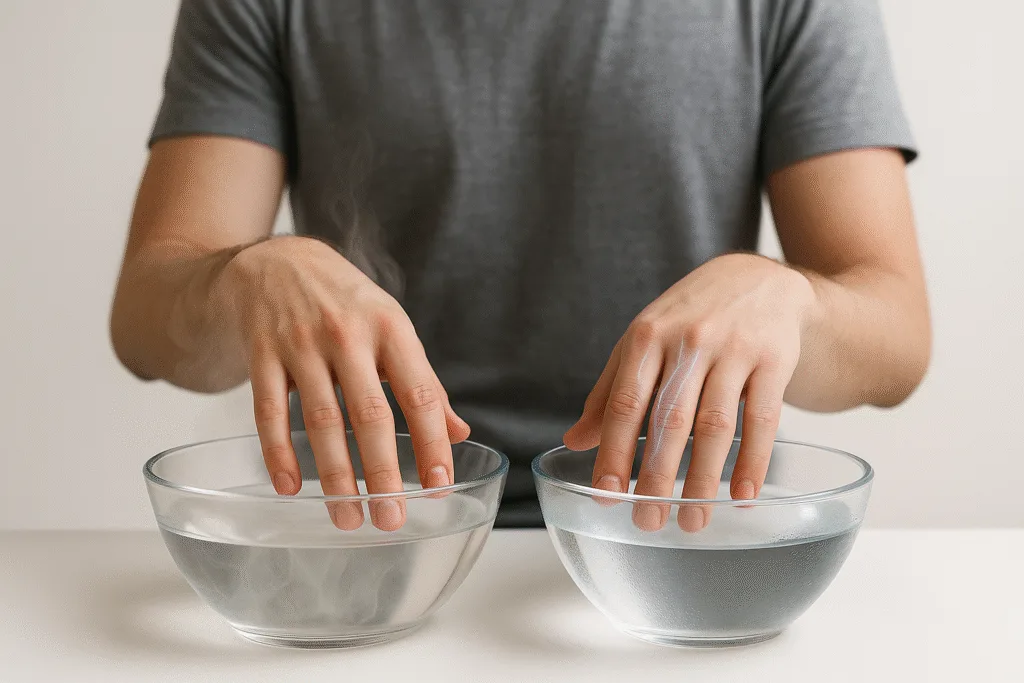The warm cold skin switch test reveals what happens when your nervous system is forced to process two opposing temperature signals in rapid sequence. Even though the experiment is safe, the reaction can feel surprisingly intense. Your skin, blood vessels and neural pathways are designed to respond to temperature changes instantly — and when you combine warm and cold stimuli, they enter a momentary competition.
This test shows how your body negotiates shock, recalibration and adaptation in real time. More importantly, it teaches you to recognize your thermal limits, a crucial form of bodily awareness that modern environments rarely allow you to explore.
Below está o experimento completo.
Step 1 — Prepare Two Temperature Sources
Use:
- a cup of warm water (not hot)
- a cup of cold water (with or without ice)
Both must be safe to touch.
This contrast sets the stage for the warm cold skin switch test.
As you prepare the two temperatures, your body is already anticipating sensations — a subtle pre-reaction that highlights how quickly the brain builds expectation patterns.
Step 2 — Immerse Two Fingers in the Warm Water for 5 Seconds
Place two fingers into the warm water and hold still.
Warmth makes nerve endings fire slowly and consistently.
It signals comfort, expansion, softness. Blood flow begins to increase, and your brain shifts into a parasympathetic response — the relaxation mode.
This simple warm exposure is necessary to “set the baseline” your brain will use in the next step.
Step 3 — Move the Same Fingers Directly Into the Cold Water
Sem pausa, transfira os dedos da água morna para a fria.
The drop in temperature hits your nerves instantly.
Unlike warmth, cold fires nerve fibers explosively. The signal is sharper, faster and more urgent. Your skin may tingle or tighten. The brain interprets the contrast as a micro-shock — completely safe, but very real.
This is the moment when warm and cold pathways compete.
Step 4 — Keep the Fingers Still and Notice the First 3 Seconds
Os primeiros segundos são os mais reveladores.
Your skin feels stretched between the memory of warmth and the immediate pressure of cold. This creates a strange dual-sensation: part of your perception expects softness, while another part receives a fast, crisp signal.
This clash is the core of the warm cold skin switch test.

Step 5 — Remove the Fingers and Hold Them in Open Air
Lift your hand and let the air hit the damp skin.
Airflow becomes a new variable.
Because warm and cold sensory pathways are still firing, the layer of air feels exaggerated — cooler than normal, sharper than expected.
You are essentially watching your sensory system reboot.
Step 6 — Repeat the Cycle One More Time
Warm → Cold → Air.
Repeating the sequence makes the sensations clearer.
On the second round:
- the warmth feels stronger
- the cold feels faster
- the air feels more defined
Your nervous system gets better at interpreting the signal because repetition lowers shock and increases accuracy.
This shows how adaptable your body really is.
Step 7 — Try the Opposite Order: Cold → Warm
Agora inverta.
Start with cold water for 5 seconds
Then slide into warm.
This reversal produces a completely different reaction.
Cold constricts vessels, tightens skin and activates alertness.
Warmth after cold feels like a release, almost like the skin “opening.”
This sensation shift teaches you how temperature influences vascular mechanics.
Step 8 — Pay Attention to the “Afterglow” Sensation
Depois da aplicação, observe:
- tingling
- light pulsing
- lingering warmth
- delayed chill
- subtle buzzing in the skin
These are micro-signals traveling through the sensory nerves that were stimulated.
The experience is not random — it is your brain reorganizing input.
This afterglow is one of the most fascinating results of the warm cold skin switch test.
Step 9 — Compare Both Sides of the Body
Faça o teste no lado oposto: outra mão, outro braço ou até outra região.
You may notice one side is:
- more sensitive
- faster to react
- slower to calm down
- more tolerant to contrast
This difference often reflects habitual use, circulation patterns, and individual nerve variability.
The test makes these invisible asymmetries obvious.
Step 10 — Step Back and Understand the Meaning of This Test
O warm cold skin switch test não é apenas uma brincadeira sensorial.
Ele revela cinco mecanismos fundamentais do corpo humano:
1. Your skin reacts at millisecond speed
Temperature receptors fire faster than almost any other sensory signal.
2. Contrast amplifies perception
Warm alone is gentle.
Cold alone is sharp.
But switching between them creates a supercharged response.
3. Your nervous system is modular
Different nerves carry warm vs. cold information — and they compete.
4. Blood flow changes instantly
Warmth expands vessels.
Cold contracts them.
Switching forces rapid vascular adaptation.
5. Your brain recalibrates constantly
Every contrast forces the brain to reset, evaluate and reinterpret input.
This experiment makes you aware of how alive, reactive and intelligent your sensory system really is.
Next Safe Extreme You Should Try
If the warm cold skin switch test revealed how your nerves compete under thermal contrast, the next experiment exposes how your balance system reacts under rotational stress.
Recommended next article:
“The Quick Spin Orientation Test — How Your Brain Regains Control After Sudden Movement”
